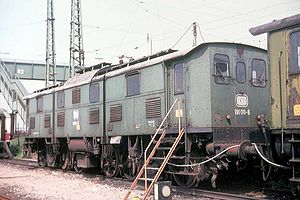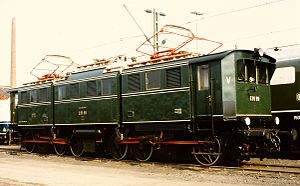History
As early as 1922 the first order was placed by the Deutsche Reichsbahn for 30 heavy goods train electric locomotives with a C+C wheel arrangement for mountain railway services, as part of their procurement plan for electric locomotives. They were delivered by Krauss (mechanical elements) and WASSEG (electrical equipment) in 1925 and 1926. Sixteen units were allocated to the Bavarian railway network. They were given the designation EG 5 22 501 – 516 by the Bavarian Group Administration. The other 14 machines were deployed to the Silesian network as EG 581 Breslau to EG 594 Breslau. From 1927 they were given operating numbers E 91 01 – 16 and E 91 81 – 94. In 1927 a further four locomotives were delivered that had been ordered with Bavarian operating numbers, but were delivered with the new numbers E 91 17 – 20.
Classes E 91 and E 77 were very similar. The three-axle driven bogies had an inside frame. Each had a double motor driving its axles via a jackshaft and Winterthur diagonal side-rod drive (Schrägstangenantrieb). The superstructure was in three sections. The front and rear sections each had a driver's cab and an engine room and were fixed to the bogies. The centre section was suspended between the front and rear sections and was articulated. The gangways between the individual sections of the engine room were protected by bellows; there were no dividing walls. The Bavarian locomotives could be easily told from their Silesian counterparts by the additional front door between the two cab windows (see photograph, right, of the Bavarian E 91 11, parked up in AW Frankfurt as a stationary transformer for the test shop. Unlike the E 91.9, it had air vents that can be clearly seen along the lower half of the sides).
The machines were to be able to haul goods trains of 1,200 tonnes at 35 km/h on a 10 ‰ incline and passenger trains of 500 tonnes at 45 km/h. Because the engines were intended for goods and passenger services, which did not require high top speeds, these locomotives fully met their intended expectations.
In the DRG, the south German engines remained permanently in Bavaria at Munich main station, Regensburg, Rosenheim and Freilassing locomotive depots. The Silesian machines, whose delivery had begun in 1925, were homed in Hirschberg/Jelenia Góra depot. Of those, numbers E 91 89 to E 91 91 were transferred to Ulm shed in the Stuttgart Reichsbahn railway division in 1933. In 1943, E 91 88 and E 91 94 were moved to Bavaria, and E 91 82, 92 and 93 followed in 1944.
The remaining engines, E 91 83 to E 91 87, were transferred to the Soviet Zone in autumn 1945. They were given to the USSR in 1946 as war reparations. After their return in 1952–53 they remained mothballed. A new lease of life on the Rübeland Railway did not come to fruition, because it soon became apparent that this line would be electrified for 25 kV, 50 Hz. The engines were retired in 1962 and scrapped in 1965.
Of the south German engines, E 91 05 had been retired in 1934 and E 91 17 in 1944. After further retirements, 17 locomotives remained in the DB fleet in 1950 (numbers E 91 01 - 03, 07 - 11, 13, 15, 16, 18, 20, 81, 88, 89 and 94) and they were modernised between 1958 and 1960, all the electrical equipment being renewed. The driver's cabs were changed (gangways and window shields removed and the third window at front and rear replaced with a larger one). On the introduction of computerised operating numbers, the locomotives were reclassified in 1969 to 191s and given three-digit running numbers. In their final years the engines were not only deployed in south German locomotive depots, but also at Oberhausen in the Ruhrgebiet. Due to their low top speed, they were mainly used on shunting duties. They were retired between 1969 and 1975.



